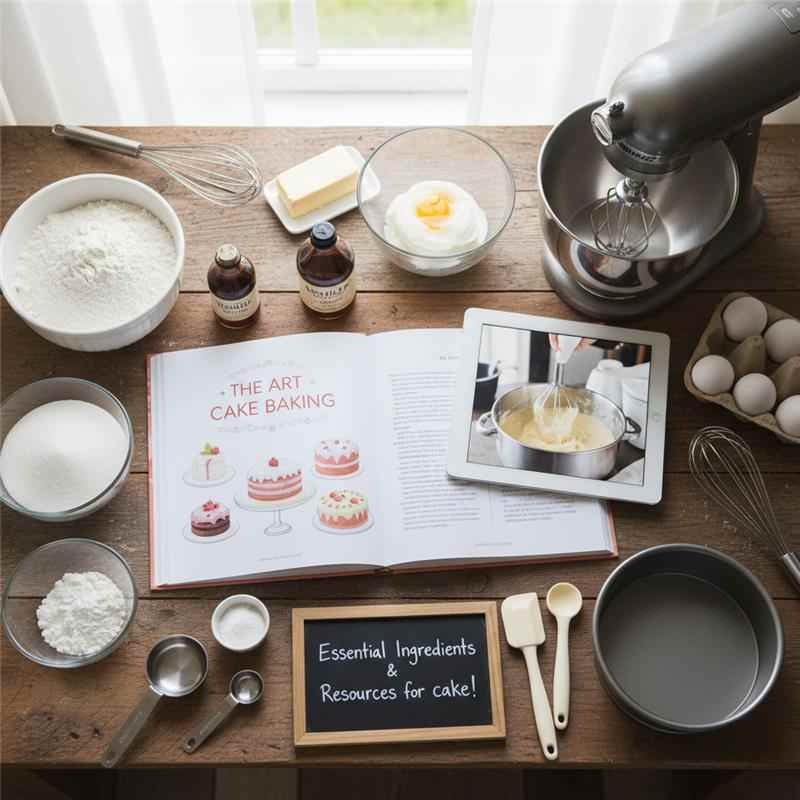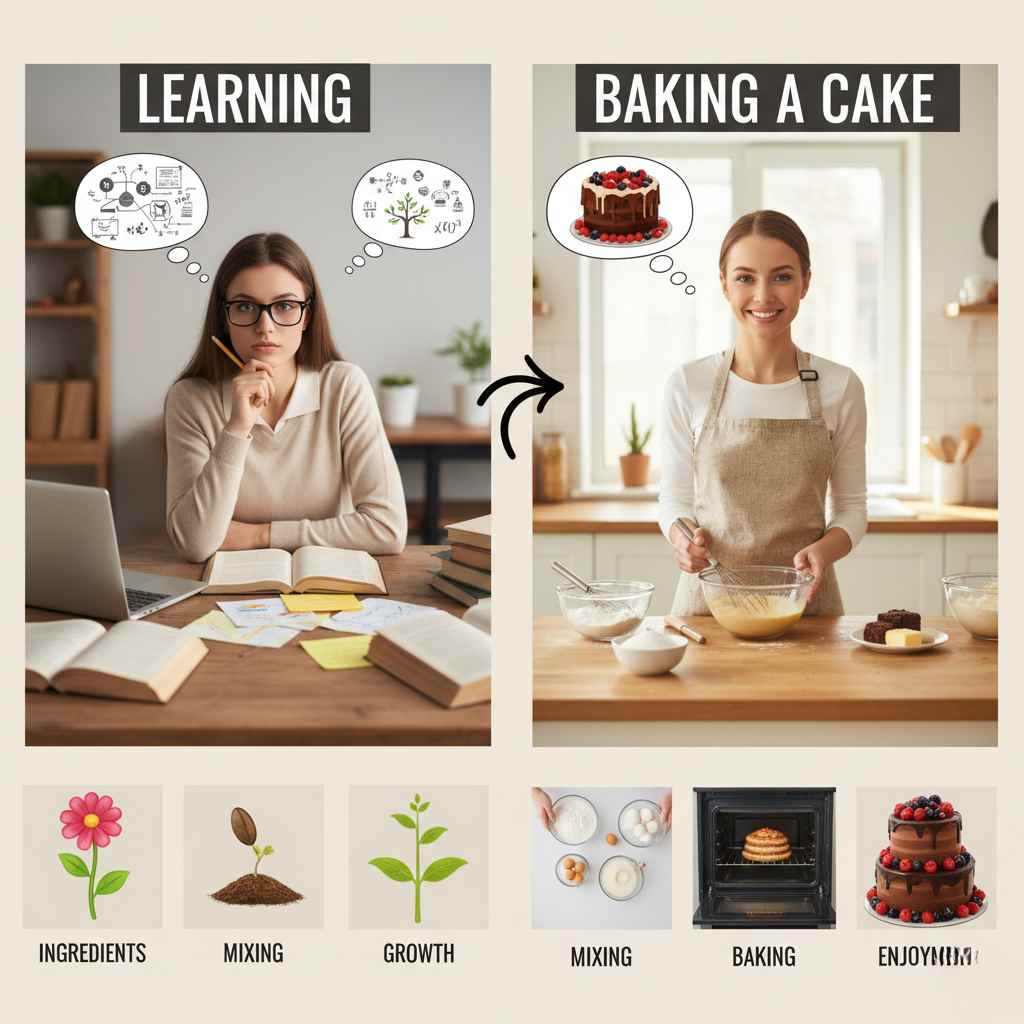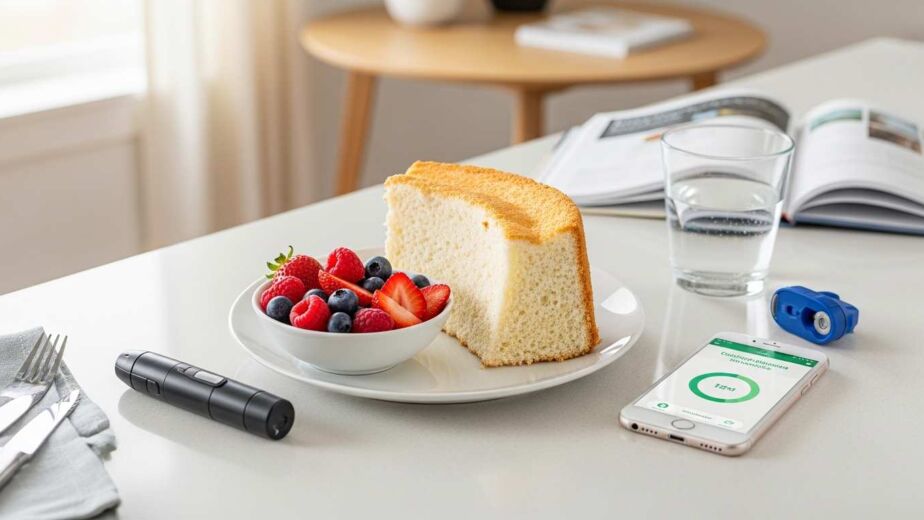When you compare learning to baking a cake, the parallels become clear: both involve following a step-by-step recipe, gathering the right “ingredients,” and practicing patience. In each case you start with a plan (the recipe or learning goal), collect materials, mix things carefully, and wait for the result. As one educator puts it, “learning is like baking a cake—it takes time, patience, and practice”. Each attempt teaches you how to do better next time. In the same way that a baker expects trials and tweaks, a learner expects mistakes and improvements. In this analogy, the structured steps, precise execution, and willingness to learn from errors in baking mirror the process of successful learning. Below we break down the main ways learning is like baking a cake.
A Structured Process (Following the Recipe)
Just as a cake needs a recipe to turn out well, effective learning follows a clear sequence of steps. You can imagine it like this:
-
Preparation (Gathering ingredients): Define your learning objective and assemble resources (your “recipe”).
-
Mixing the basics: Learn and combine the fundamental concepts, much like mixing flour, sugar, and eggs.
-
Baking time (Practice): Apply what you’ve learned through exercises and practice—this is when knowledge “cooks” and solidifies.
-
Finishing touches (Mastery): Review, reflect, and refine what you’ve learned (like decorating a cake) so you can explain or teach it to someone else.
Each step builds on the last. Just as you wouldn’t bake a cake without preheating the oven or without sifting dry ingredients, you shouldn’t skip the basics in learning. Experts stress that there is “no royal road to learning” – you can’t shortcut these steps. In other words, you can’t rush from zero to mastery in one jump; each phase of learning must be done carefully. Skipping steps or trying to cram everything at once often leads to gaps in understanding. The structured, step-by-step nature of learning is what ensures success – just like following the recipe order is essential for a good cake.
Essential Ingredients and Resources
Learning, like cake-making, depends on having the right ingredients. For a cake you need flour, eggs, sugar, etc.; for learning you need things like clear goals, quality study materials, and time. As one educational handbook notes, “Learning is like baking a cake. All cakes have a basic set of ingredients; so does learning”. These learning “ingredients” might include textbooks or lectures (the flour and sugar of knowledge), practice problems (the eggs that bind ideas), and a supportive study environment (the oven that provides the right conditions). If any key ingredient is missing or poorly balanced, the result can fail – just as “if a child has 25 kg of flour, but no eggs, the cake will flop”.
Key learning ingredients often include:
-
Clear objectives: Knowing what you want to learn (the recipe or goal).
-
Resources: Books, articles, videos, teachers, and tools (the raw ingredients).
-
Effort and skill: Time spent studying and practicing skills (the mixing and baking).
-
Feedback/support: Help from teachers or peers (tasting the batter and adjusting flavor).
Educators even compare planning a course to choosing cake ingredients. One guide explains that, “like baking a cake, creating learning experiences requires careful planning, thoughtful ingredient selection”. In other words, both baking and learning demand that you pick and prepare high-quality ingredients (or resources) before you begin.

Mixing It Right: Precision and Execution
Baking well means measuring and mixing with care, and learning is no different. You must pay attention to details and do things at the right pace. For example, a baker who rushes when folding egg whites into batter can end up with a flat cake. Similarly, rushing through lessons can leave gaps in understanding. Even a simple mistake—like forgetting a key term—can throw off the whole process.
It’s normal for early attempts to be imperfect. As one educator found, your first try at baking may “result in a pretty awful outcome,” but each trial teaches you something. Perhaps you learn to “measure ingredients precisely” or to bake a bit longer next time. That trial-and-error is essential. In learning, this means paying attention to detail (just as you would watch the oven thermometer) and being precise. Gradually introducing new ideas and practicing them carefully—rather than cramming too fast—ensures concepts blend together properly, just like ingredients. The key is a balanced approach and steady mixing: go gentle and steady when learning complicated ideas, and be patient with the process.
Practice, Adjustments, and Feedback
Learning, like baking, often involves several tries, each time tweaking the “recipe” for better results. After mixing and baking your cake, you might taste it and decide it needs more vanilla or a longer baking time. In learning, after a practice test or homework, you review mistakes and adjust your study strategy. Each loop of practice and feedback is a chance to improve.
This iterative cycle is how mastery is built. With each round, you fold in what you’ve learned and make the next layer more refined. One expert notes that trial and error is essential for improvement. In practice, that might mean reworking study notes, asking questions when confused, or trying a different approach if one doesn’t work. Just as a baker might add a pinch more salt or lower the oven temperature on the next bake, a learner might allocate more time to a tricky topic or seek a tutor’s help. These adjustments—whether in the kitchen or the classroom—ensure the final product (cake or knowledge) turns out as intended.
Mistakes Are Opportunities
In both baking and learning, mistakes are not failures; they’re opportunities to learn. Even experienced bakers sometimes end up with a sunken cake or too-crispy edges. In the same way, students often get a problem wrong or forget a step. Importantly, experts emphasize that this is normal. Education researchers say that “mistakes are a natural—and necessary—part of the learning process,” and that making errors “can give us opportunities for growth”.
When your cake cracks or your cake batter is lumpy, you don’t give up—you figure out what went wrong. Likewise, if you don’t understand a math problem, that mistake shows exactly what you need to review. Taking time to acknowledge errors and reflect on them helps you identify gaps. As one teaching guide explains, “acknowledging mistakes and reflecting on them offers students a chance to actively engage in the learning process and identify areas where they struggle”. In short, every burned cake or wrong answer teaches you how to adjust the recipe or your study plan for next time.
Patience and Persistence
Good cakes and deep learning both take time. You can’t pull a cake out of the oven halfway through and hope it’s done, and you can’t grasp a subject by skimming it once. You need to bake and let it rise, and you need to review and rehearse information. As an eLearning expert summarizes, learning (like baking) “takes time, patience, and practice.”. When that timer ticks, it’s not wasted – it’s essential waiting time that completes the process.
Stay persistent. If the cake isn’t rising or you still can’t solve the problem, give it more time or another practice session. Each retry and each minute of focus adds up. Just as a baker might set the oven timer and walk away, a learner needs to study a little bit each day rather than all at once. Over time, small efforts snowball into success. The reward – finally tasting a delicious cake or truly understanding a topic – is well worth the wait.
Conclusion
Comparing learning to baking a cake highlights that success in either comes from a thoughtful recipe, the right ingredients, and practice through each step. If you approach your studies as a baker would approach a cake – planning ahead, using quality materials, mixing carefully, and learning from each outcome – you’ll get more consistent, satisfying results. Both processes teach us that small, patient efforts and adjustments lead to a “tastier” learning experience. So the next time you bite into a piece of cake or tackle a challenging lesson, remember: a great outcome often comes from the same formula of preparation, precision, perseverance, and openness to improve.



